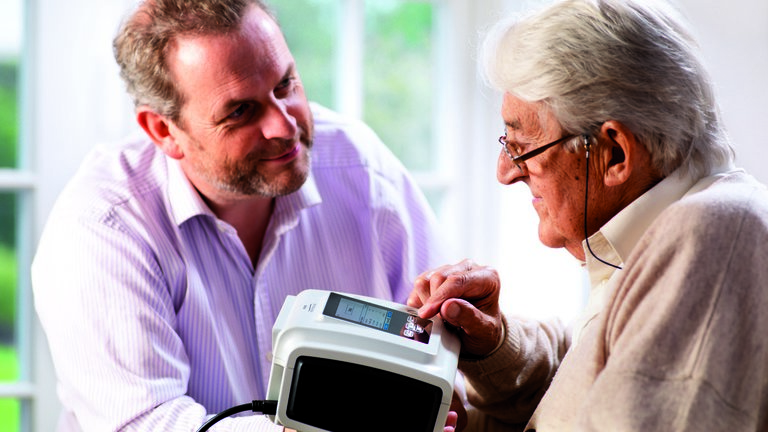About Ventilation Therapy
What is Non-Invasive Ventilation?
Non-Invasive Ventilation (NIV) is normally used when oxygen levels in the blood are low and carbon dioxide levels are high. The ventilator helps you breathe out more carbon dioxide.
The term is used to describe how the ventilator (air pump) delivers air to your lungs under pressure which helps keep your airways and the air sacs in your lungs open and inflated.
Non-invasive means that this process
is achieved simply by using a mask.
The ventilator automatically recognises when you breathe in, then assists and supports each breath you take working with your natural breathing pattern. This support means that you can take more air in with each breath, allowing more air into your lungs. You will also be able to get rid of the waste product carbon dioxide more easily, making you feel less breathless.
The airflow is strongest when you breathe in to help you take in as much air as possible, meaning that airflow is lower when you breathe out. This is commonly referred to as BiPAPTM (Bi-level Positive Airway Pressure).
The respiratory system
The primary function of the respiratory system is to supply the blood with oxygen in order for the blood to deliver oxygen to all parts of the body. The respiratory system does this through breathing.
When we breathe, we inhale oxygen
and exhale carbon dioxide.
This exchange of gases is how the respiratory system gets oxygen to the blood. This is where the lungs come in.
You also need a muscle called the diaphragm – The diaphragm’s job is to help pump the carbon dioxide out of the lungs and pull the oxygen into the lungs. The diaphragm is a sheet of muscles that lies across the bottom of the chest cavity. As the diaphragm contracts and relaxes, breathing takes place. When the diaphragm contracts, oxygen is pulled into the lungs. When the diaphragm relaxes, carbon dioxide is pumped out of the lungs.
There are two main reasons that problems and difficulties can happen with your breathing:
- Obstruction: this is where the waste gas, the carbon dioxide is not able to leave the body as it should do. If it stays in your body it can cause breathlessness and coughing.
- Muscle weakness: this is where your diaphragm does not work as well as it should to control the pumping of air in and out of your body. This means that not enough oxygen is brought into your blood cells.
Respiratory failure
Oxygen is needed to feed the blood cells and help all parts of your body work properly.
People who have problems with their respiratory system, known as respiratory failure, may develop other symptoms, such as:
-
Restlessness
-
Confusion
-
Breathlessness
-
Headaches
-
Drowsiness
These can develop because of the lack of oxygen in the blood cells as well as having too much carbon dioxide in the body.
Therapy benefits
-
Improved lung function
-
Better oxygen intake
-
Breath more efficient
with improved flushing out of carbon dioxide -
Feel more alert
and have more energy
to perform tasks during the day, after a better night time sleep -
Reduced morning headaches
-
Reduced re-admissions to hospital


